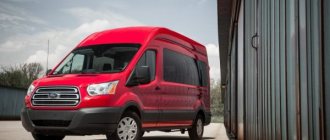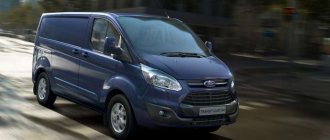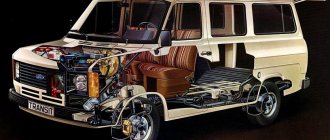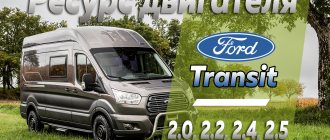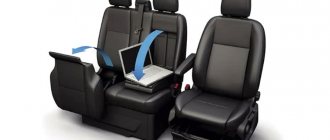Home Brands Ford Ford Transit Custom
In 2012, the European division of the American company Ford launched a new commercial vehicle model called the Ford Transit Custom. It is a mid-size van, which went into production due to the desire to compete with leading commercial vehicle manufacturers Volkswagen and Mercedes-Benz, namely with their Transporter and Vito models.
The company produces a similar car in the form of a shuttle bus, which is called Tourneo Custom. To say that Ford management hit the mark is an understatement. The car instantly gained popularity and immediately became van of the year in Europe in 2012.
Body design and versions
Restyling took place in 2022, as a result of which the car’s appearance was significantly corrected, the interior was re-equipped and work was done on the cargo compartment, but the technical component remained unchanged.
The model is most popular among small and medium-sized urban businesses, that is, Ford Transit Custom spends most of its life within the city limits, because it is not afraid of bans on the passage of freight vehicles. The company's designers understood this, so the car turned out to be purely urban. Modern features and smooth lines. It differs from its passenger brother only in the metal plugs in place of the windows. Because of this, it looks more utilitarian, but no less attractive.
From the front, the car looks harmonious and relevant. It will not be difficult to confuse it with ordinary transit. Compared to its predecessor, the false radiator grille, front optics and front bumper were replaced. The latter has become more massive and prominent. In the center there is a large hexagonal false radiator grille with horizontal partitions; in its central part there is the traditional logo of the American brand.
The front optics of the Ford Transit Custom look attractive with a complex shape and beautiful content. Two compartments are visible to the naked eye: for the low beam lamp and the high beam lamp. The compartments are surrounded by LED running lights. Lighting organs are also located in the corners of the front bumper in multi-level plastic niches. The fog lamps are hidden under the transparent glass.
A large air intake with horizontal cross members is integrated into the middle part of the front bumper. The hood slopes down at a large negative angle, and its outer parts have a noticeable muscularity. The differences between the Custom and the regular Transit are the windshield; if on the regular Transit part of the roof extends far forward, then the Custom windshield goes almost to the horizontal position of the roof.
Transit Custom also looks impressive and dynamic in profile. The first thing that catches your eye is the wide wheel arches and massive stamping along the window sill line. In the “base” it comes on classic stamped wheels, but for an additional fee there can be nice light alloys. In the rear part, in profile, you can see the rails for the side door of the van, and on the side door itself, like the front one, there is a wide molding.
The rear of the van looks modest and utilitarian, on which it is worth highlighting the vertically oriented optics, consisting of two parts: narrow and wide. Also striking is the rear door handle and the location where the license plate is attached. At the very top you can see a narrow strip of “stops”, and in the corners of the rear bumper there are small fog lights.
For Russian consumers, the car is available with a standard length and an extended wheelbase. The van has the following dimensions:
- length – 4973 mm or 5340 mm;
- width – 2290 mm;
- height – 2022 mm;
- distance between axles – 2933 mm or 3300 mm;
- gross weight - 2,499 kg, 2.7 tons, 3.3 tons;
- load capacity from one ton to one and a half;
- cargo compartment volume – 6 cubic meters or 6.8 cubic meters.
Feelings behind the wheel
The first thing I noticed when I started the engine was that an important drawback had disappeared, due to which the previous Transit was seriously inferior to the Mercedes-Benz Sprinter and VW Crafter. The operation of the diesel engine at idle speed in Ford's competitors of recent years could only be seen from the cockpit by the tachometer on the dashboard; the Transit Custom was a bit noisy compared to them, and vibration was also felt. Now there is no trace of this problem.
The steering wheel is covered in leather, the finishing materials are also at a decent level, but here are the first losses. There are significantly fewer pockets and niches for small items, documents, cans and bottles, for which I simply adored the Ford Transit dashboard of earlier generations. Again, when compared to the Sprinter, the Transit Custom has an absolute advantage here. And don’t forget that this car is more compact, there was a place to put a backpack and a place for a bottle of mineral water. Nothing prevented you from getting comfortable in the driver's seat. Now let's go!
We had to drive out of the parking lot in reverse. Lifting the chrome locking ring on the lever, I engaged the gear and looked in the mirror as usual. To the left, then to the right, and in the interior mirror I found a color image from a video camera, framed by the markings of the parking radar. Before this, this was only found in the options of expensive cars. “What else will they come up with next time?” – I thought as I drove the newest Ford Transit Custom onto the smooth German Autobahn...
…Having turned off the reverse gear, I discovered that the color image from the video camera had disappeared on the interior rearview mirror, and the navigator suggested taking a walk along the roads of rural Germany. Apparently I'm fed up. It's just a comfortable car, where everything is like everyone else's. No emotions. Until I stalled at the first traffic light, rare in these parts. To start the engine, I squeeze the clutch, and before I even pick up the ignition key, I hear the sound of the starter working, after which the engine instantly starts. Here it is, a button that activates the “eco” mode, and in this mode the “start-stop” function is activated, but I forgot about it. And since I became acquainted with this system in such a sudden way, I will immediately note its excellent performance. Previously, I had to try this function, and on those cars it took subjectively longer to start. Let's put a plus sign.
Ford Transit Custom Cabin Interior
Overall, the interior turned out to be modern, stylish and ergonomic. From the front, it differs little from the interior design of Ford passenger cars. In front of the driver lies a multifunctional three-spoke steering wheel, followed by a modern and informative dashboard. On the large monitor of the multimedia system, and air ducts extend from the sides of it. Under the multimedia complex there is a climate control unit. Not far away, the gearshift knob found its place in a “suspended” form.
As for the seats, the driver has a comfortable seat with developed lateral support and good filling, as well as an individual armrest. To the side of it is a double sofa, where two more passengers can sit with less comfort, but without any difficulty.
The cargo compartment of the Transit Custom deserves special attention. As mentioned, it can hold up to 6,000 and 6,800 liters, depending on the configuration. Transportation of large-sized cargo is available, the length of which does not exceed 3.3 meters. The cargo compartment is separated from the passenger compartment by a plastic covering. It can also boast a flat floor and almost flat walls, which are lined with fiberboard.
The quality of materials and the level of their assembly for the van can be assessed with the highest rating.
Engine and gearbox
| Engine model | DRFG | CYFF |
| Type | Turbo diesel | Turbo diesel |
| Working volume | 2198 cm³ | 2198 cm³ |
| Power | 100 hp | 125 hp |
| Torque | 310 H*m at 2000 rpm | 350 H*m at 2000 rpm |
| Number of cylinders | 4 | 4 |
| Number of valves | 16 | 16 |
| Environmental class | Euro-4 | Euro-4 |
| Transmission | 6-speed manual transmission | 6-speed manual transmission |
| Maximum speed | 100 km/h | 100 km/h |
| Fuel consumption | 7.0 l. | 7.0 l. |
As for the power unit, it is represented by a four-cylinder turbocharged diesel engine with a displacement of 2.2 liters. It is available in two modifications: 100 hp. and 310 Nm of torque and 125 hp. and 350 Nm of torque.
This engine is paired with a six-speed manual transmission, which transmits all torque exclusively to the front axle of the Ford Transit Custom. This tandem allows a commercial Ford to accelerate to 157 km/h, and consumption in the combined cycle is only 7.5 liters per 100 km.
Advantages and disadvantages
The car has two significant disadvantages that add a fly in the ointment. The first of them is the lack of a high roof in the pre-restyling. The second is the high requirements of the Common Rail system for fuel quality.
Pros:
- practicality;
- stylishness;
- mobility;
- efficiency;
- reliability.
It is not for nothing that they believe that the creation of the Ford Transit Custom is a brilliant step from the company. With this model, most entrepreneurs have the opportunity to quickly and mobilely deliver their goods and cargo within the city, without causing inconvenience to themselves and others.
Scary dream "Caravels"
As I looked at the neatly lined up minibuses and various van variants, I thought that the competitors from Wolfsburg were now plagued by insomnia and nightmares. Indeed, for decades (!) in this segment of light commercial vehicles and minibuses, the Volkswagen Transporter family and their derivatives Caravella and Multivan, which compete in price with the Mercedes-Benz Vito and Viano, have been openly and secretly leading. In Russia, Hyundai Starex, which are at the junction of the UPV and minivan classes, are also successfully sold at a very reasonable price. Until that time, Ford practically did not have cars of this class.
Ford representatives have not yet announced the price for the new product, this is the main intrigue of the no longer updated, but a completely different “Transit”. If the price is lower than its main competitors, then the Transit Custom will become a “bomb” on the market, because this class is popular and in demand in Russia.



